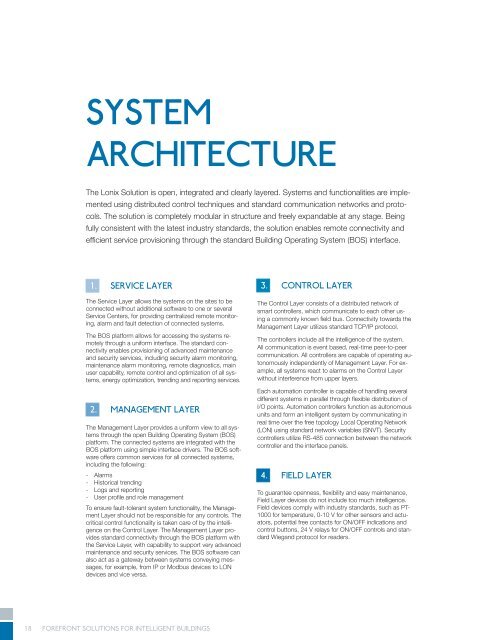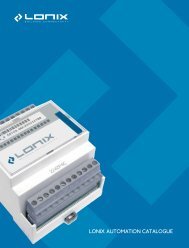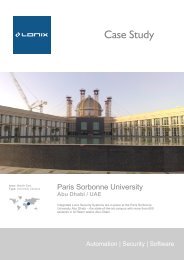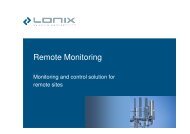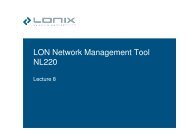LONIX SOLUTION CATALOGUE
LONIX SOLUTION CATALOGUE
LONIX SOLUTION CATALOGUE
Create successful ePaper yourself
Turn your PDF publications into a flip-book with our unique Google optimized e-Paper software.
SYSTEM<br />
ARCHITECTURE<br />
The Lonix Solution is open, integrated and clearly layered. Systems and functionalities are implemented<br />
using distributed control techniques and standard communication networks and protocols.<br />
The solution is completely modular in structure and freely expandable at any stage. Being<br />
fully consistent with the latest industry standards, the solution enables remote connectivity and<br />
effi cient service provisioning through the standard Building Operating System (BOS) interface.<br />
1. SERVICE LAYER<br />
The Service Layer allows the systems on the sites to be<br />
connected without additional software to one or several<br />
Service Centers, for providing centralized remote monitoring,<br />
alarm and fault detection of connected systems.<br />
The BOS platform allows for accessing the systems remotely<br />
through a uniform interface. The standard connectivity<br />
enables provisioning of advanced maintenance<br />
and security services, including security alarm monitoring,<br />
maintenance alarm monitoring, remote diagnostics, main<br />
user capability, remote control and optimization of all systems,<br />
energy optimization, trending and reporting services.<br />
2. MANAGEMENT LAYER<br />
The Management Layer provides a uniform view to all systems<br />
through the open Building Operating System (BOS)<br />
platform. The connected systems are integrated with the<br />
BOS platform using simple interface drivers. The BOS software<br />
offers common services for all connected systems,<br />
including the following:<br />
- Alarms<br />
- Historical trending<br />
- Logs and reporting<br />
- User profi le and role management<br />
To ensure fault-tolerant system functionality, the Management<br />
Layer should not be responsible for any controls. The<br />
critical control functionality is taken care of by the intelligence<br />
on the Control Layer. The Management Layer provides<br />
standard connectivity through the BOS platform with<br />
the Service Layer, with capability to support very advanced<br />
maintenance and security services. The BOS software can<br />
also act as a gateway between systems conveying messages,<br />
for example, from IP or Modbus devices to LON<br />
devices and vice versa.<br />
3. CONTROL LAYER<br />
The Control Layer consists of a distributed network of<br />
smart controllers, which communicate to each other using<br />
a commonly known fi eld bus. Connectivity towards the<br />
Management Layer utilizes standard TCP/IP protocol.<br />
The controllers include all the intelligence of the system.<br />
All communication is event based, real-time peer-to-peer<br />
communication. All controllers are capable of operating autonomously<br />
independently of Management Layer. For example,<br />
all systems react to alarms on the Control Layer<br />
without interference from upper layers.<br />
Each automation controller is capable of handling several<br />
different systems in parallel through fl exible distribution of<br />
I/O points. Automation controllers function as autonomous<br />
units and form an intelligent system by communicating in<br />
real time over the free topology Local Operating Network<br />
(LON) using standard network variables (SNVT). Security<br />
controllers utilize RS-485 connection between the network<br />
controller and the interface panels.<br />
4. FIELD LAYER<br />
To guarantee openness, fl exibility and easy maintenance,<br />
Field Layer devices do not include too much intelligence.<br />
Field devices comply with industry standards, such as PT-<br />
1000 for temperature, 0-10 V for other sensors and actuators,<br />
potential free contacts for ON/OFF indications and<br />
control buttons, 24 V relays for ON/OFF controls and standard<br />
Wiegand protocol for readers.<br />
18<br />
FOREFRONT <strong>SOLUTION</strong>S FOR INTELLIGENT BUILDINGS


